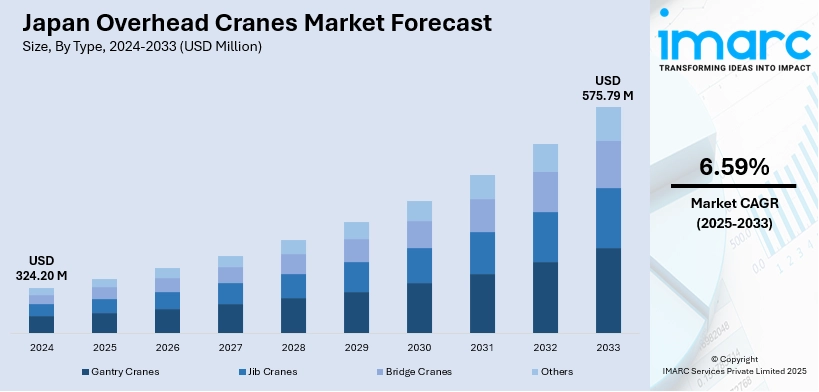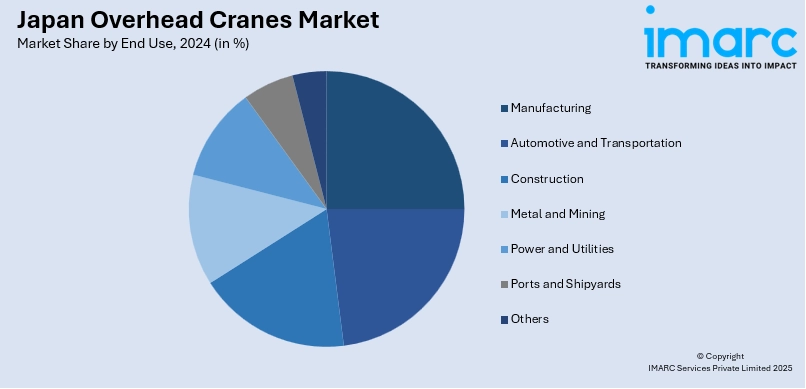
Japan Overhead Cranes Market Size, Share, Trends and Forecast by Type, Lifting Capacity, End Use, and Region, 2025-2033
Japan Overhead Cranes Market Overview:
The Japan overhead cranes market size reached USD 324.20 Million in 2024. Looking forward, IMARC Group expects the market to reach USD 575.79 Million by 2033, exhibiting a growth rate (CAGR) of 6.59% during 2025-2033. Increased industrial automation, growing demand in manufacturing sectors, advancements in crane technology, expanding infrastructure projects, and the need for efficient material handling solutions in construction, automotive, and shipping industries, boosting productivity and safety, are some of the factors contributing to Japan overhead cranes market share.
|
Report Attribute
|
Key Statistics
|
|---|---|
|
Base Year
|
2024
|
|
Forecast Years
|
2025-2033
|
|
Historical Years
|
2019-2024
|
| Market Size in 2024 | USD 324.20 Million |
| Market Forecast in 2033 | USD 575.79 Million |
| Market Growth Rate 2025-2033 | 6.59% |
Japan Overhead Cranes Market Trends:
Rising Demand for Domestic Efficiency in Material Handling
Japan’s market for overhead cranes is seeing stronger activity as manufacturers adjust their supply networks across Asia. With more companies shifting production to countries like Vietnam to reduce reliance on China, regional output is growing, and that creates ripple effects back to Japan. Increased regional production volume means more raw materials and goods are moving, which puts pressure on Japanese factories and logistics centers to improve internal handling operations. Businesses are upgrading to more efficient crane systems to keep pace with this shift in regional demand and to support flexibility in supply chain operations. Domestic suppliers in Japan stand to gain from this adjustment, especially in sectors prioritizing speed and automation. These factors are intensifying the Japan overhead cranes market growth. For example, in December 2024, Mitsui E&S plans to build a new crane production facility in Vietnam, aiming to meet rising global demand from companies shifting supply chains away from China. This move reflects broader demand for crane systems across Asia. Japan's overhead crane market would also benefit through increased regional manufacturing activity and supply chain diversification, spurring demand for efficient material handling solutions domestically.

To get more information on this market, Request Sample
Shift toward Compact and High-Precision Systems in Urban Facilities
Japan’s industrial landscape is changing as manufacturers increasingly move operations into urban or semi-urban areas to stay close to end-users and transport hubs. This shift is prompting a noticeable preference for compact, high-precision overhead crane systems designed for tight spaces and complex workflows. Unlike traditional large-scale cranes used in sprawling industrial zones, newer installations are optimized for lower ceilings, narrower bays, and tighter maneuvering—all without sacrificing lifting capacity or safety. Japanese firms specializing in robotics, automotive parts, and electronics are leading this shift, often requiring cranes that integrate seamlessly with automated production lines and digital monitoring tools. Demand is rising not just for hardware, but for systems that support remote diagnostics, predictive maintenance, and smart load control. This reflects a broader move toward space-efficient, intelligent infrastructure that maximizes productivity per square meter. Suppliers that can deliver these solutions, either through modular designs or embedded sensor technology, are gaining traction. As urban manufacturing gains momentum, the crane sector is aligning closely with the need for precise, flexible, and tech-enabled lifting equipment that matches the constraints and ambitions of modern production spaces.
Japan Overhead Cranes Market Segmentation:
IMARC Group provides an analysis of the key trends in each segment of the market, along with forecasts at the country and regional levels for 2025-2033. Our report has categorized the market based on type, lifting capacity, and end use.
Type Insights:
- Gantry Cranes
- Jib Cranes
- Bridge Cranes
- Others
The report has provided a detailed breakup and analysis of the market based on the type. This includes gantry cranes, jib cranes, bridge cranes, and others.
Lifting Capacity Insights:
- Up to 5 Ton
- 6-10 Ton
- 11-50 Ton
- More Than 50 Ton
A detailed breakup and analysis of the market based on the lifting capacity have also been provided in the report. This includes Up to 5 ton, 6-10 tone, 11-50 ton, and more than 50 ton.
End Use Insights:

- Manufacturing
- Automotive and Transportation
- Construction
- Metal and Mining
- Power and Utilities
- Ports and Shipyards
- Others
A detailed breakup and analysis of the market based on the end use have also been provided in the report. This includes manufacturing, automotive and transportation, construction, metal and mining, power and utilities, ports and shipyards, and others.
Regional Insights:
- Kanto Region
- Kansai/Kinki Region
- Central/Chubu Region
- Kyushu-Okinawa Region
- Tohoku Region
- Chugoku Region
- Hokkaido Region
- Shikoku Region
The report has also provided a comprehensive analysis of all the major regional markets, which include Kanto Region, Kansai/Kinki Region, Central/Chubu Region, Kyushu-Okinawa Region, Tohoku Region, Chugoku Region, Hokkaido Region, and Shikoku Region.
Competitive Landscape:
The market research report has also provided a comprehensive analysis of the competitive landscape. Competitive analysis such as market structure, key player positioning, top winning strategies, competitive dashboard, and company evaluation quadrant has been covered in the report. Also, detailed profiles of all major companies have been provided.
Japan Overhead Cranes Market Report Coverage:
| Report Features | Details |
|---|---|
| Base Year of the Analysis | 2024 |
| Historical Period | 2019-2024 |
| Forecast Period | 2025-2033 |
| Units | Million USD |
| Scope of the Report |
Exploration of Historical Trends and Market Outlook, Industry Catalysts and Challenges, Segment-Wise Historical and Future Market Assessment:
|
| Types Covered | Gantry Cranes, Jib Cranes, Bridge Cranes, Others |
| Lifting Capacities Covered | Up to 5 Ton, 6-10 Ton, 11-50 Ton, More Than 50 Ton |
| End Uses Covered | Manufacturing, Automotive and Transportation, Construction, Metal and Mining, Power and Utilities, Ports and Shipyards, Others |
| Regions Covered | Kanto Region, Kansai/Kinki Region, Central/Chubu Region, Kyushu-Okinawa Region, Tohoku Region, Chugoku Region, Hokkaido Region, Shikoku Region |
| Customization Scope | 10% Free Customization |
| Post-Sale Analyst Support | 10-12 Weeks |
| Delivery Format | PDF and Excel through Email (We can also provide the editable version of the report in PPT/Word format on special request) |
Key Questions Answered in This Report:
- How has the Japan overhead cranes market performed so far and how will it perform in the coming years?
- What is the breakup of the Japan overhead cranes market on the basis of type?
- What is the breakup of the Japan overhead cranes market on the basis of lifting capacity?
- What is the breakup of the Japan overhead cranes market on the basis of end use?
- What is the breakup of the Japan overhead cranes market on the basis of region?
- What are the various stages in the value chain of the Japan overhead cranes market?
- What are the key driving factors and challenges in the Japan overhead cranes market?
- What is the structure of the Japan overhead cranes market and who are the key players?
- What is the degree of competition in the Japan overhead cranes market?
Key Benefits for Stakeholders:
- IMARC’s industry report offers a comprehensive quantitative analysis of various market segments, historical and current market trends, market forecasts, and dynamics of the Japan overhead cranes market from 2019-2033.
- The research report provides the latest information on the market drivers, challenges, and opportunities in the Japan overhead cranes market.
- Porter's five forces analysis assist stakeholders in assessing the impact of new entrants, competitive rivalry, supplier power, buyer power, and the threat of substitution. It helps stakeholders to analyze the level of competition within the Japan overhead cranes industry and its attractiveness.
- Competitive landscape allows stakeholders to understand their competitive environment and provides an insight into the current positions of key players in the market.
Need more help?
- Speak to our experienced analysts for insights on the current market scenarios.
- Include additional segments and countries to customize the report as per your requirement.
- Gain an unparalleled competitive advantage in your domain by understanding how to utilize the report and positively impacting your operations and revenue.
- For further assistance, please connect with our analysts.
 Request Customization
Request Customization
 Speak to an Analyst
Speak to an Analyst
 Request Brochure
Request Brochure
 Inquire Before Buying
Inquire Before Buying




.webp)




.webp)












